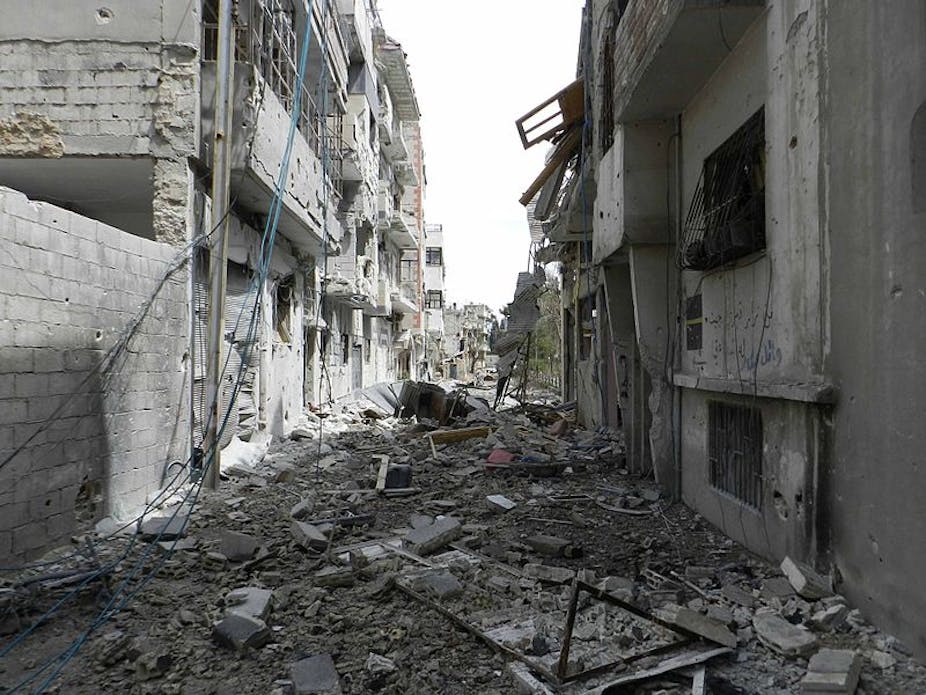President Obama had always insisted that any use of chemical weapons by the regime of Bashar al-Assad would be a “red line” which should not be crossed. The rhetoric emanating from the White House implied that the consequences of crossing this line would be significant.
Washington has clarified what these consequences would be – not direct intervention involving US planes patrolling a “no-fly zone” or US army “boots on the ground”, but indirect intervention involving US weaponry being shipped to the rebel Syrian National Council as part of a new proxy war strategy that could have a significant impact upon the longevity of violence and the wider politics of the region.
Since hostility to Assad’s rule spilled over into armed resistance in 2011, Obama has been reticent to take an international lead on ushering the end of the Syrian regime. This mirrored his initial caution over intervening in other Arab Spring uprisings - and only in the outlying case of Libya did he eventually agree to participate in the form of limited air strikes.
With Syria, Obama has allowed some European countries, namely the UK and France, to beat a loud drum for regime change. The US decision to sanction arms shipments comes more than two weeks since the British and French foreign ministers successfully engineered the lapse of EU embargoes on arms shipments to Syria and nearly two years after rebel leaders first started openly requesting weapons. It must be remembered, however, that the US has already provided millions of dollars-worth of what was labelled “non-lethal equipment” (such as communications devices) over the past year.
Shades of Afghanistan
Yet there may be good reason for Obama’s caution. The US legacy of fighting proxy wars, especially during the Cold War period, is chequered. Its last major proxy war undertaking – involving the support for the mujahideen in Afghanistan during the Soviet occupation in the 1980s – should give us pause for thought. The rationale for the Reagan administration’s indirect intervention in Afghanistan finds echoes in that of Obama’s decision regarding Syria.

Charles Cogan, the then CIA station chief in Afghanistan, justified their involvement in these plain terms: “We took the means to wage war, put them in the hands of people who could do so, for the purposes for which we agreed.” The “means to wage war” Cogan referred to involved training 50,000 rebel fighters and providing them with $3 billion worth of funding. Some of this money went towards purchasing surface-to-air Stinger missiles, designed to nullify the Soviet air monopoly.
Perhaps it should come as no surprise that the Syrian rebels have been most vocal in their desire to receive anti-aircraft missiles above all other weaponry as a way of similarly invalidating the potency of Assad’s air force on rebel-held areas.
The cautionary tale from the Afghan case is acute. The Stinger missiles provided by the US to the Afghan mujahedeen found themselves used in conflicts much further afield after the Soviets withdrew in 1989. The use of Stinger missiles by non-state actors with whom no direct Stinger sales have been made, but who had interaction with Afghan groups who were supplied with US Stingers, has been reported in Bosnia, Iran, Kashmir, Tunisia and the Palestinian territories in the years after the Soviet withdrawal.
US aid backfired spectacularly
So concerned did Washington get at the proliferation of Stinger usage that President George HW Bush authorised a $65m “buy-back” programme to help the CIA retrieve as many of the missiles as possible. The results of this initiative were negligible, with only a small fraction of the Stingers recovered, leaving somewhere between 300-600 unaccounted for. The effects of this particular proxy war decision long outlasted both the original conflict it was designed to influence and unwittingly spilled over the borders of the country they were intentioned for. This is a lesson the advocates of indirect intervention in Syria today would be well minded to heed.

The Soviet–Afghan war killed 1.3m people, with 5.5m more turned into refugees – one third of the nation’s pre-war population. The jihadist diaspora that was created at the end of the Afghan war ignited a new wave of fundamentalism. One of the most significant consequences of US inattention to Afghanistan after 1989 (when the proxy war objective of Soviet withdrawal was achieved) was the sanctuary now on offer to an international array of jihadist militants. By the mid-1990s the Taliban had won control of large swathes of the country.
As a result Afghanistan was established as a safe haven for Islamic fundamentalism, compounded by the fact that the US had no clear policy formulated to deal with the issue. Although the US may have helped end one war they unwittingly sowed the seeds for the start of another one, which was made startlingly clear on September 11, 2001.
This brief foray into the proxy war past of the US is designed to serve as a reminder of the potentially deleterious consequences of deciding to arm your enemy’s enemy. Unforeseen future “blowback”, such as Stinger missiles leaving Afghanistan to be used against America, is something that Donald Rumsfeld would perhaps have called a “known unknown”. As we await Russia and Hizbollah’s response to the US decision, we should take on board the cautionary tales of proxy wars from the recent past in order to make more sense of the dangerous “known unknowns” that they all inevitably bring.

